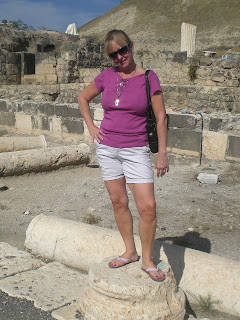Today we went to Bet She'an National Park with Lisa and Chuck Haas and Mike Christian. It was a truly beautiful day. I kept teasing everyone....."oh yeah, we get to see more rocks........and they are all old!" but I had a great time.
The settlement of Bet She'an first began in the fifth millennium B.C.E. on the Tel rising to the south of the Harod River, in the heart of a fertile area enjoying an abundance of water and located on a major crossroads.
In the late Canaanite period (16th-12th centuries B.C.E.), the city became the seat of Egyptian rule. The Israelite tribes did not succeed in conquering Canaanite Bet She'an. After the battle waged at Mt. Gilboa, the Philistine lords of Bet She'an displayed the bodies of Saul and his sons on the city walls. The city was later taken by King David along with Megiddo and Ta'anach, becoming the administrative center of the region during King Solomon's reign. The site was destroyed in 732 B.C.E., with the conquest of the northern part of the country by the Assyrian king, Tiglat-Pilesser III. During the Hellenistic period, the city known as Nysa-Scythopolis was founded on this spot. Local lore has it that Dionysos, the god fo wine, buried his nurse Nysa here, subsequently settled the region with Scythians from among his followers.
At the end of the 2nd century B.C.E. the city fell to the Hasmoneans. Its gentile residents were exiled and the city's population became predominantly Jewish. The city was once again dominated by gentiles following the Roman conquest in 63 B.C.E. As one of the ten cities of the Decapolis, it became the most important city in northern Israel. During the revolt against the Romans in 66 C.E., the city's Jewish residents were murdered by their gentile neighbors. Under Roman rule, when the popultion consisted of pagans, Jews and Samaritans, the city thrived and expanded, with magnificent public buildings going up, engraved with inscriptions and adorned with statues. In the Byzantine period, Bet She'an became largely Christian, its population reaching 30,000-40,000. A wall was erected around the city, with churches and monasteries near it. In the aftermath of the Arab conquest, the city steadily declined in prominence and the number of its inhabitants dwindled. A severe earthquake in 749 C.E. became known as Beisan. A rural settlement was built at the site during the Abbassid period. During the Medieval period, the settlement was concentrated in the city's southern part, and during the Crusader period, a fortress was put up to the east of the destroyed amphitheater. Under Ottoman rule, Beisan remained a small settlement.
Bet She'an has begun to develop and flourish once again since the establishment of the State of Israel. The city takes great pride in the impressive remains of the ancient city which is slowly being uncovered in its midst.
 |
| Roly......our tour guide! |
|
 |
| Add caption |
 |
| Roly holding up the pillars while Chuck watches |
 |
| Chuck Haas, Mike Christian and Roly |
 |
| Roly using the public lavatories |


























No comments:
Post a Comment